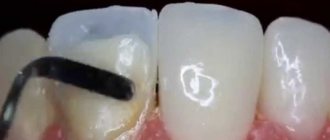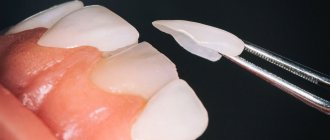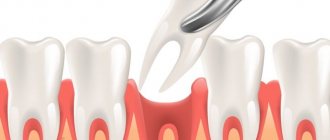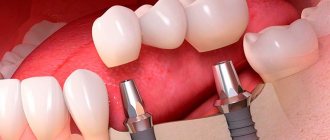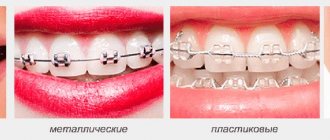Over the course of a person's life, cracks sometimes form in the enamel of teeth. It can break off, wear off, or become covered with irregularities. Visual errors sometimes haunt the patient from childhood. Having gained access to the possibilities of modern medicine, an adult strives to take advantage of them and add shine and shine to his own smile.
Therapeutic veneers are extremely popular as an alternative to invasive orthopedic intervention in the functionality of the anterior teeth. Due to their reasonable price, they have surpassed expensive ceramic linings in the popularity rankings. The advantages of the mentioned technique reconcile patients with some disadvantages, but the issue of the appropriateness of installing therapeutic veneers is always discussed with the doctor in advance.
What are therapeutic veneers
Therapeutic veneers are additionally called composite veneers due to their composition. Onlays consist of a special light-hardening material that allows you to smooth out roughness, breaks and cracks on the front surface of the tooth, or change its shape.
Another name for these veneers is direct. It is explained by the way the structure is installed. The component is layered onto the vestibular surface of the front teeth and is immediately corrected. This is a creative work that requires the dentist to have experience and artistic vision, and the ability to foresee the result. Direct veneers are created in the patient's mouth in 2-3 hours. Therefore, a person no longer has to wait many days before he gets a beautiful smile and returns to his daily activities transformed.
Composite veneers (componeers)
They are made from filling material in two ways and differ in how veneers are placed on the teeth:
1. Aesthetic filling (therapeutic) - installation occurs in one stage. Specialist. Using equipment, the doctor polishes the front side of the tooth. Then filling material is applied to this plane. Apply as thin a layer as possible. This method can hide only minor aesthetic problems.
2. Production of composite plates in a dental laboratory using special impressions. Before installing veneers on the front teeth, the dentist grinds down the enamel. The process requires several steps, so the implants are fixed at subsequent appointments.
The downside is that the service life of composite veneers is 5 years. A significant disadvantage is also a change in the color of the plates - darkening of the cladding.
Advantages and disadvantages of veneers using the direct method
The advantages of the technique are mainly associated with the relative simplicity and high speed of production of onlays:
- Veneers are installed in one clinic visit. No preliminary making of impressions, fitting or installation of temporary structures is required.
- The enamel is turned in a gentle way, to a depth of up to 0.7 mm, sometimes less. If the tooth is not sick, manipulations are kept to a minimum. For example, only part of the tooth is processed or no preparation is done at all.
- Modern photocomposite materials reliably imitate human dental tissue. As a result, the therapeutic veneer is practically indistinguishable from adjacent healthy teeth.
- Accidental damage to part of the veneer will not become an obstacle to correcting the situation. At the appointment, the doctor will remove the layered composition that has lost its usefulness and install a new one.
- The price of direct veneering is truly considered budgetary and is available to everyone, including students and retirees. Ceramic structures are much more expensive.
The latter circumstance often becomes decisive. However, along with the advantages, the doctor certainly voices the disadvantages of the technique, giving the person the opportunity to make an informed choice.
Price
| Included in the price |
|
| Paid separately |
|
| Affect the cost |
|
Obvious disadvantages of direct veneering:
- Therapeutic veneers gradually change shade. The microporous structure absorbs the pigments of food elements over the years and becomes darker. To prevent the development of such a situation, the patient must limit his own diet and try to avoid foods with bright, persistent enamel coloring. The list includes red wine, beets, strong tea, etc.
- Shorter service life compared to ceramic plates. This is explained by the loose fit of the composite to the tooth tissues, which provokes the accumulation of plaque in the lacunae and crevices. Bacteria readily inhabit these cavities, contributing to the development of caries.
- Hardness bordering on brittleness. Direct veneers crack when subjected to strong force and cannot be restored.
The listed disadvantages can be limited if you follow the rules of hygiene and take care of the installed veneer. Medical technologies do not stand still, and the first two disadvantages gradually cease to be decisive for the patient. The materials used are constantly improving the adhesive ability and expanding the possibilities of extending the service life.
Luxneers - veneers are installed without tooth preparation and without pain. Diastema, tremata, curvature, salts of teeth are corrected. It is advisable to bring a panoramic image of the OPTG to the consultation.
Is it possible to replace an old veneer with a new one?
There is no exact service life and replacement time for old linings. The shade of the existing plates simply changes or their surface becomes leaky, and caries begins under the composite (if ceramics are installed, the development of caries is practically excluded). The clinic removes the old structure, the cost of the procedure is 3900 rubles per tooth. And a replacement is immediately selected for them.
There are frequent requests from patients who once had composite veneers installed, but today they would like to change them to ceramic ones, including those made using CEREC technology. Emax veneers are of ideal quality and speed of production. A new Cerec veneer can be obtained in 1.5 hours, and such veneers do not require an adjustment period.
How to create a Cerec overlay:
- The enamel is processed and the tooth is scanned. No cast needed.
- A three-dimensional model of the overlay is created taking into account the physical data.
- An automatic machine turns a prosthesis from an array of pressed ceramics.
- The veneer should be tried on and fixed.
If questions arise or the shade does not match, a corrected copy will be received within a few minutes. But such cases are rare. Veneers are ideally fixed even on uneven teeth - if the installation work is carried out by an experienced specialist. The perfect fit of the plates prevents bacteria and food particles from getting under the lining.
Indications for installation of veneers
Therapeutic veneers are indicated when only the facial surface of the tooth is destroyed. If the problem lies in the side or back, a direct veneer is not sustainable.
Most often, a composite is used to cover cracked enamel, stains on the surface, or a noticeable boundary between the filling material and the living tissues of the tooth that arose during the treatment of caries. Sometimes in these cases the enamel is ground down locally, which reduces the area of trauma.
Direct veneers are excellent at hiding pigment spots that cannot be bleached. For example, indications for installing an onlay will be tetracycline teeth.
The increased sensitivity of teeth to whitening components will lose its significance if the tooth changes its shade to snow-white by layering the composite substance. It can correct the shape of a tooth, eliminate diastema, correct size, and eliminate minor curvature.
It happens that tooth enamel wears away over the years, then direct veneers will come to the rescue. They will also correct the situation with damaged enamel after wearing braces for a long time.
Who are veneers contraindicated for?
People who have the following diseases and problems are not recommended to get implants.
• The presence of a dental anomaly “bruxism” is a forceful clenching of the jaws during sleep.
• Insufficient amount of tooth enamel.
• Bite pathology, meaning straight, deep bite.
• Caries and its complications.
• A group of diseases that are characterized by inflammatory processes - gingivitis, periodontal disease, etc. These diseases are a temporary contraindication. After treatment, the structures are successfully installed.
• Severe tooth fragility, or the presence of a bulky filling.
Contraindications
However, in most cases, veneers will not replace the braces system. A thin plate cannot hold the tooth in an orthodontically correct position. Therefore, significant occlusion will become an obstacle to the application of a composite in order to improve the aesthetics of the dentition.
Addition to the list of contraindications:
- Teeth destroyed by caries. The installation of a veneer also excludes the case when the filling makes up a large part of the tooth, especially if it occupies almost the entire vestibular surface.
- Periodontal inflammation;
- Unsatisfactory hygienic condition of the oral cavity;
- Tendency to uncontrollable grinding of teeth, mainly in sleep;
- Engaging in contact sports (boxing, martial arts), when there is a high risk of breaking a fragile veneer;
- Indulging in the habit of cracking seeds with incisors, biting threads, etc.
Also, in most cases, the doctor will refuse to install a composite veneer on the surface of a chewing tooth, where the load on the component will be too great to ensure that it remains intact.
Recovery and rehabilitation period
You should not eat until the anesthesia wears off after the veneers are installed. Don't bite or chew anything. Also, after the procedure, a combination of taking hot and cold together is not recommended.
You should definitely come for a preventive examination. Your doctor should schedule a date for you to check that your teeth are aligned correctly.
If you have problems such as bruxism or malocclusion, you should wear special protective mouth guards. Also, do not neglect preventive examinations. Another important point is that after installing veneers, you should periodically perform oral hygiene (2 times a day or after each meal).
How direct veneers are installed
The installation of therapeutic veneers occurs directly during a visit to the dentist’s office.
- The doctor examines the condition of the patient’s teeth and collects information. If there are no obstacles, teeth are cleaned and tartar is removed. Sometimes preliminary treatment of caries is required, then the installation of veneers is postponed.
- The enamel is prepared to a small thickness, sometimes only locally, not over the entire surface of the tooth. At the patient's request, anesthesia is used; there is no need to endure pain.
- Then etching of the exposed area is used to improve the adhesion of the composite material to the tissues of the living tooth.
- The doctor applies the substance of the future veneer layer by layer onto the prepared tooth, simultaneously forming and fixing the composite. An LED or UV lamp is used for curing.
- Finally, grinding and final polishing are performed, as a result of which the tooth acquires the appearance of a natural one.
Some patients attribute the need to keep their mouth open for a long time as a subjective disadvantage. To prevent muscles from getting tired, the doctor uses intermaxillary inlays. However, you need to psychologically prepare for possible slight discomfort.
What materials are veneers made from?
Only veneers made from a ceramic composition can be considered original.
Sometimes in dentistry, visitors are offered the fixation of veneers made of other materials - on an aluminum or zirconium base. As a budget alternative to such veneers, veneers created from composite can be compared. The production of such veneers in the Russian Federation differs significantly from the technologies usual in Europe. True composite veneers must be produced within the framework of a professional dental laboratory operating in dentistry. Veneers are given a shape identical to the parameters of the patient’s teeth. This is achieved through the preliminary creation of impressions. Impressions for veneers are taken by orthopedic dentists during the process of preparing teeth for attaching veneers.
In Moscow, most clinics do not have their own laboratories, so composite veneers are created in violation of real technology. Such veneers turn into analogues of ordinary filling masses. Veneers are fixed on the surface of the front teeth during treatment procedures using standard restorative compounds with light-curing fillings. This turns the veneer into a typical falsification.
Ceramic veneers
Veneers made from high-quality ceramics have long been awarded the title of Hollywood. Such veneers are often considered analogues of indirect veneers and orthopedic veneers. Such names are dictated by the manufacturing features. The creation of such veneers is not done in dentistry during the session, but in a special laboratory before the start of therapy.
In all the variety of ceramic veneers, two large varieties can be distinguished. In addition to porcelain veneers, Moscow dentists suggest considering the installation of veneers made of zirconium alloys.
Porcelain veneers
Porcelain is rightfully considered the base material for creating veneers. It is most similar to the appearance of human tooth enamel and its structure. The increased strength of the material and the preservation of color throughout the entire service life of the veneers cannot be ignored. Additional translucency improves the aesthetic qualities of veneers.
restoration of front teeth with veneers before and after photos
Quite often, patients are not satisfied with the condition of the restoration of their front teeth. To correct the situation, dental specialists suggest completely eliminating the unsuccessful restoration and fixing veneers made of first-class porcelain to the teeth.
There are two methods that can be used to make porcelain veneers:
The first technique helps achieve maximum aesthetics, and the second is aimed at obtaining maximum strength indicators of the incisors. The method according to which the specialist will act is determined by the dentistry you contacted. The average production time for veneers ranges from one to two weeks. At this time, your ground teeth will be covered with special temporary veneers made of high-quality plastic.
Veneers. Method of layer-by-layer application of porcelain mass and firing it
One of the most common situations considered by employees of any dentistry is the creation of veneers for the fourth and fifth teeth. Dentists prefer to apply a special porcelain mixture to the client’s prepared teeth. It is distributed over the teeth gradually and in layers. During the work process, a dental specialist can vary the thickness, color and level of transparency of the layer to create the highest quality veneers on the visitor’s teeth. This technique allows you to achieve a perfect match of the color of nearby teeth. This is what gives the look a natural look.
Veneers. Injection molding method under pressure and high temperature
Now we are talking about “pressed ceramics”. Veneers produced using this method become less fragile, which contributes to long-lasting wear and increased reliability.
Porcelain veneers for front teeth: before and after photos
Zirconium dioxide ceramic veneers
Zirconium veneers have two layers. The lower one is made up of a high-strength zirconium frame, and the outer surface of the veneer is represented by a porcelain mass. The frame is created using a unique technology of three-dimensional milling of veneers. Dentistry using this technology must have CNC machines. They do not require human intervention, therefore they guarantee products of impeccable quality and accuracy.
The procedure consists of several successive steps. First, in dentistry, a specialist grinds the patient’s teeth for installation of veneers, after which he makes a reliable impression of each incisor being processed. Based on the impression taken, a virtual three-dimensional model of the future veneer will be built using special dental equipment. The operator transfers the data of the simulated veneer to the machine for turning the workpiece.
Zirconium veneers are stronger and harder than pressed porcelain veneers. An excellent result can be achieved in any dentistry in Moscow if its employees strictly follow the technology of firing the resulting blanks for veneers. Unfortunately, it is not uncommon for clinics to violate accepted technology. The technique is completely new, and not every dentist has managed to master it at the proper level. Deviation from the original technology is fraught with the formation of chips on the ceramics after installing veneers on a patient.
Making veneers photo process
Ceramic veneers: reviews, advantages
In addition to excellent aesthetics, installing ceramic veneers in dentistry can achieve:
- — complete color stability throughout the entire service life of the veneers;
- - incredible reliability (the service life of veneers is limited only by a person receiving dental injuries in extreme situations).
The only drawback of ceramic veneers is their rather high price.
Differences between porcelain veneers and zirconium dioxide veneers: By installing porcelain veneers, dental professionals are able to achieve incredible translucency of the material. Zirconium products have more modest translucency indicators because they have increased density.
For patients with a high level of transparency in their own teeth, it is advisable to choose veneers made from a porcelain mixture. For some clients, the tooth enamel has a more saturated color. Then veneers of these two varieties will be quite appropriate. Porcelain veneers can be given the desired degree of translucency by varying the number of layers.
Sign up for a consultation at our clinic
What happens after the procedure
The person leaves the clinic with a beautiful smile and returns to everyday life. In an effort to extend the service life of composite veneers, the patient is obliged to follow the recommendations of the attending physician. Oral hygiene is performed as usual, the constant use of floss is recommended, and a desire is expressed to buy an irrigator for better cleaning of teeth.
After 30 days, a follow-up appointment will follow, at which the dentist will examine the veneer and monitor the patient’s compliance with the rules of care. Once every six months, polishing of the composite will be required to maintain the presentable appearance of the lining. Of course, if the integrity of the veneer is compromised or there is suspicion of caries arising under the structure, an appointment with a doctor is required.
Service life and care
Unfortunately, the service life of composite veneers is another aspect in which they are inferior to ceramic plates. Unlike the latter, which last for decades, composite overlays require renewal approximately every 4 years. In terms of care, in addition to the standard meticulous daily hygiene with a toothbrush, toothpaste, floss and irrigator, composite restorations also require periodic polishing. Therefore, you should not skip visits to the hygienist. There is no need to subject the pads to excessive mechanical stress: gnawing or biting anything with force. You can wear protective mouth guards at night to avoid accidental breakage. It is recommended to visit a doctor once every six months for a professional assessment of their condition.
Caring for therapeutic veneers
Aspects and rationales for care relate to the intricacies of the composition and installation of therapeutic veneers. Recommended:
- Avoid putting pressure on teeth with onlays;
- Minimize the content of brightly colored foods and drinks with dyes in the diet;
- Love hygiene and carefully observe it;
- Visit your dentist regularly.
Composite veneers come in handy when you want to quickly and inexpensively transform your smile. If the defects are not too strong and there are no contraindications, it is worth taking advantage of the achievements of dentistry and changing the appearance of the teeth.
Is it possible to get veneers without grinding teeth?
In order to avoid grinding down the enamel, veneers made from feldspar and E-max should be inserted; they are thinner and do not require such a procedure.
It is possible to refuse turning if:
1. You have uneven teeth;
2. If the teeth are heavily worn;
3. It is necessary to change the direction of a crooked tooth;
4. It is necessary to add volume to the tooth.
There are no ideal teeth, so veneers without grinding cannot yet be placed. Except if the teeth are sparse and not voluminous. Grinded teeth can no longer be restored in the future, so you will always need to install crowns or their equivalents.
Dental restoration at Dentistoff Dentistry
The professionals at the Dentistoff scientific clinic always focus on methods that will allow your teeth to undergo minimal grinding, keeping them intact and alive.
Composite veneers will allow you to inexpensively and quickly eliminate tooth decay and defects, restoring not only a snow-white smile, but also self-confidence.
And the service and cozy atmosphere of the Dentistoff clinic, the high professionalism of the staff and the most modern techniques guarantee you a safe and painless aesthetic restoration.
Call now!
Inexpensive alternative to complex prosthetics
Unfortunately, not everyone can boast of perfect teeth. But even those who have had no problems with a perfect smile since childhood eventually turn to the dentist to solve aesthetic problems. Defects and chips of teeth, pigmentation on enamel, unevenness of teeth and gaps between them…. Is it really necessary to solve these problems by an expensive restoration with complete surface resurfacing?
Scientific dentistry "Dantistioff" offers you an excellent, inexpensive and quick solution to the problem - composite veneers.
